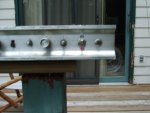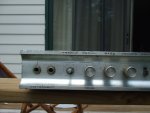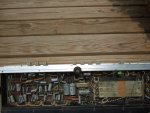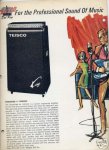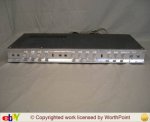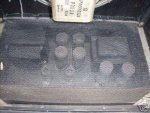Does the amp motor boat with the input pot at zero?
If not are you feeding the guitar into the "LF rolloff" input via the cap? If not try that.
Also if the amp is stable with no input it is because it was never meant to be fed from the odd, shitty impedance that is an electric guitar! Do you have a pedal? Try that since it will present a nice low impedance to the first valve's grid.
If it MBs with the grid at earth lift the feedback resistor and cap, 3k3 and .001.
If it is still not stable I am a bit stumped but a voltage table might throw up an idea or two! OTTOMH I would say the coupling caps, C26/27 were 5 times bigger than they need be (and 20x bigger for guitar work!)
V4 is not a "pre amp" valve. It is the voltage driver to the output valves. V5 is just a PI of a type known as the "Paraphase" aka "Concertina" inverter and has a gain of one!
Do you intend to use this AS a guitar amplifier or for Hi-Fi?
Dave.
If not are you feeding the guitar into the "LF rolloff" input via the cap? If not try that.
Also if the amp is stable with no input it is because it was never meant to be fed from the odd, shitty impedance that is an electric guitar! Do you have a pedal? Try that since it will present a nice low impedance to the first valve's grid.
If it MBs with the grid at earth lift the feedback resistor and cap, 3k3 and .001.
If it is still not stable I am a bit stumped but a voltage table might throw up an idea or two! OTTOMH I would say the coupling caps, C26/27 were 5 times bigger than they need be (and 20x bigger for guitar work!)
V4 is not a "pre amp" valve. It is the voltage driver to the output valves. V5 is just a PI of a type known as the "Paraphase" aka "Concertina" inverter and has a gain of one!
Do you intend to use this AS a guitar amplifier or for Hi-Fi?
Dave.


